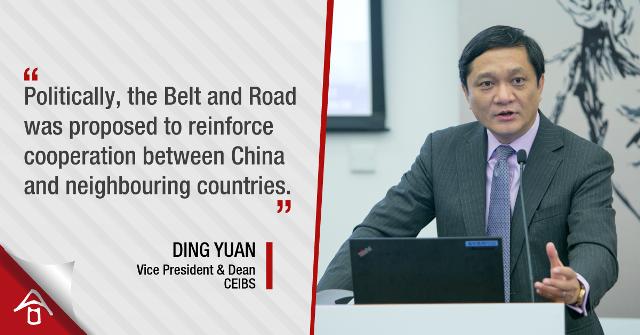Explainer: China’s Belt and Road Initiative

China’s ambitious Belt & Road Initiative (BRI) is among the topics that will be discussed during CEIBS Europe Forum in London on July 6. Ahead of the event, we provide an explanation of the BRI.
“This major initiative was proposed only after careful thought about every aspect of its significance. Politically, ‘the Belt and Road’ was proposed to reinforce cooperation between China and neighbouring countries within the context of a new framework, enhance the output of China’s soft power and improve its status in the international community.
It’s a significant social responsibility for China. If it goes as well as we imagine it will, China will win over a lot more friends politically, discover new sources of economic growth, and bring concrete added value to local communities.
For Chinese enterprises, it implies abundant development and investment opportunities. On one hand, many traditional industries in China that are up against saturated markets and overcapacity will find new sources of growth from export. On the other hand, after more than 30 years of constant inflow of massive amounts of funds, Chinese capital is also motivated to find its way out of the country.”
~ CEIBS Vice President & Dean Professor Ding Yuan
“The Belt and Road” Defined
“On September 7, 2013, during a speech at Nazarbayev University in Kazakhstan, China’s President Xi Jinping spoke of his vision of collaborating on the construction of a Silk Road Economic Belt. On October 3 of the same year, Xi addressed the Indonesian Parliament and proposed working together on a 21st Century Maritime Silk Route. The two speeches constitute two halves of the “Belt and Road Initiative”.
With the joint efforts of China and the countries along the route, “Belt and Road” has become a golden route for exchanges and collaborations across the globe, covering China and western countries and reaching both the southern and northern hemispheres.
RMB20 trillion in trade
China has been actively promoting mutually open markets to further facilitate trade. From 2014 to 2016, the total volume of trade between China and countries along the “Belt and Road” reached RMB20 trillion, growing faster than the global average.
More than US$50 billion in ODI
In terms of investment and cooperation, China has been reinforcing the quality of services provided to cross-border investors to encourage enterprises to invest and start businesses in countries along the “Belt and Road”. From 2014 to 2016, Chinese overseas direct investment in countries along the “Belt and Road” exceeded US$50 billion and the value of new contracted projects in the countries reached US$304.9 billion. Meanwhile, China further relaxed restrictions on foreign investment to create a high-level international business environment and attract investment from countries along the “Belt and Road”.
Major Projects
In collaboration with interested parties, China promoted the successive implementation of a range of major projects. Construction of the Sino-Laos Railway, Phase II of the Pakistan-Karakorum Highway and the Karachi Expressway are already underway while the construction or operation of the Sino-Russia, Sino-Kazakhstan and Sino-Myanmar Oil and Gas Pipelines is also proceeding in an orderly manner.
Overseas Economic and Trade Cooperation Zones
Chinese enterprises have successively built 56 overseas economic and trade cooperation zones in 20 countries along the “Belt and Road” and have invested a total of more than US$18.5 billion to date, contributing more than US$1.1 billion in taxes and 180,000 jobs to the host countries. The China-Belarus Industrial Park has grown into a jewel along the Silk Road economic belt while the Suez Economic and Trade Cooperation Zone, Thai-Chinese Rayong Industrial Zone, Sihanoukville Special Economic Zone, etc. are also under construction.
Free Trade Zones
China has signed free trade agreements with ASEAN, Singapore, Pakistan, and other countries and regions along the “Belt and Road”. The China-ASEAN Free Trade Area Upgrading Protocol came into effect in July 2016. China is also about to sign a free trade agreement with Georgia. It is currently actively promoting negotiations on Comprehensive Economic Partnerships (RCEPs) and free trade zones with Israel, the Maldives, Sri Lanka, and the GCC.”
(Source: people.com.)













